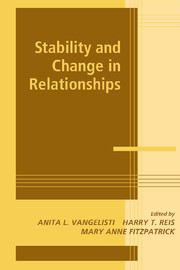Book contents
- Frontmatter
- Contents
- Contributors
- Preface
- PART ONE ACTORS: THE SCAFFOLDING OF STABILITY AND CHANGE
- 1 Change in Relationship Knowledge Representations
- 2 Personality Effects on Personal Relationships over the Life Span
- 3 An Intergenerational Model of Romantic Relationship Development
- 4 How Relationships Begin and End: A Genetic Perspective
- PART TWO BEHAVIORS: THE PROCESSES OF STABILITY AND CHANGE
- PART THREE CONTEXTS: SOCIAL ENVIRONMENTS FOR STABILITY AND CHANGE
- Author Index
- Subject Index
1 - Change in Relationship Knowledge Representations
Published online by Cambridge University Press: 21 October 2009
- Frontmatter
- Contents
- Contributors
- Preface
- PART ONE ACTORS: THE SCAFFOLDING OF STABILITY AND CHANGE
- 1 Change in Relationship Knowledge Representations
- 2 Personality Effects on Personal Relationships over the Life Span
- 3 An Intergenerational Model of Romantic Relationship Development
- 4 How Relationships Begin and End: A Genetic Perspective
- PART TWO BEHAVIORS: THE PROCESSES OF STABILITY AND CHANGE
- PART THREE CONTEXTS: SOCIAL ENVIRONMENTS FOR STABILITY AND CHANGE
- Author Index
- Subject Index
Summary
Over the past decade, researchers have begun to examine how people think about and construct their knowledge of close relationships. Little agreement exists about the nature of representations of relationship knowledge, although many theorists have proposed general definitions using concepts such as relational schemas (Baldwin, 1992, 1995; Miell, 1987; Planalp, 1987), internal working models (Bowlby, 1973; Collins & Read, 1994), prototypes (Bartholomew & Horowitz, 1991; Fehr & Baldwin, 1996; Klohnen & John, 1998), lay relationship theories (Fletcher & Thomas, 1996), interpersonal schemas (Safran, 1990), interpersonal scripts (e.g., Baldwin, 1992; Stern, 1985; Tomkins, 1979), and stories (Murray & Holmes, 1994; Sternberg, 1996). While these concepts differ somewhat in their underlying assumptions about the nature of the representation (for reviews, see Baldwin, 1992, 1995; Singer & Salovey, 1991), they are similar in two respects. First, relationship representations are thought to consist of well-organized, elaborated abstract knowledge about the self, others, and the interaction between the two that is derived from direct experiences. Second, relationship representations are assumed to be organized in some hierarchical fashion, including superordinate, abstract generalizations (e.g., “My mother is loving”) at the higher levels and specific information (e.g., “She takes care of me when I'm sick”) at the lower levels (e.g., Baldwin, 1992; Planalp, 1987).
- Type
- Chapter
- Information
- Stability and Change in Relationships , pp. 5 - 34Publisher: Cambridge University PressPrint publication year: 2002
- 4
- Cited by



